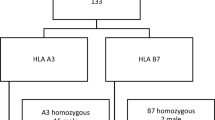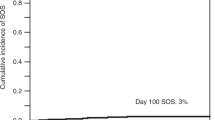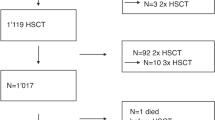Summary:
Hepatic veno-occlusive disease (HVOD) is a serious complication of hematopoietic stem cell transplantation (HSCT). Since the liver is a major site of iron deposition in HFE-associated hemochromatosis, and iron has oxidative toxicity, we hypothesized that HFE genotype might influence the risk of HVOD after myeloablative HSCT. We determined HFE genotypes in 166 HSCT recipients who were evaluated prospectively for HVOD. We also tested whether a common variant of the rate-limiting urea cycle enzyme, carbamyl-phosphate synthetase (CPS), previously observed to protect against HVOD in this cohort, modified the effect of HFE genotype. Risk of HVOD was significantly higher in carriers of at least one C282Y allele (RR=3.7, 95% CI 1.2–12.1) and increased progressively with C282Y allelic dose (RR=1.7, 95% CI 0.4–6.8 in heterozygotes; RR=8.6, 95% CI 1.5–48.5 in homozygotes). The CPS A allele, which encodes a more efficient urea cycle enzyme, reduced the risk of HVOD associated with HFE C282Y. We conclude that HFE C282Y is a risk factor for HVOD and that CPS polymorphisms may counteract its adverse effects. Knowledge of these genotypes and monitoring of iron stores may facilitate risk-stratification and testing of strategies to prevent HVOD, such as iron chelation and pharmacologic support of the urea cycle.
This is a preview of subscription content, access via your institution
Access options
Subscribe to this journal
Receive 12 print issues and online access
$259.00 per year
only $21.58 per issue
Buy this article
- Purchase on Springer Link
- Instant access to full article PDF
Prices may be subject to local taxes which are calculated during checkout


Similar content being viewed by others
References
Lee SJ, Anasetti C, Kuntz KM et al. The costs and cost-effectiveness of unrelated donor bone marrow transplantation for chronic phase chronic myelogenous leukemia. Blood 1998; 92: 4047–4052.
Popplewell L, Forman SJ . Allogeneic hematopoietic stem cell transplantation for acute leukemia, chronic leukemia, and myelodysplasia. Hematol Oncol Clin North Am 1999; 13: 987–1015.
Georges GE, Storb R . Stem cell transplantation for aplastic anemia. Int J Hematol 2002; 75: 141–146.
Barth E, Malorgio C, Tamaro P . Allogeneic bone marrow transplantation in hematologic disorders of childhood: new trends and controversies. Haematologica 2000; 85: 2–8.
Kallianpur AR . Supportive care in the hematological malignancies. In: Lee GR, Foerster J, Lukens J, Paraskevas F, Greer JP and Rodgers GM (eds). Wintrobe's Clinical Hematology, 10th edn. Williams and Wilkins, Baltmore, Maryland, 1999.
Bearman SI . The syndrome of hepatic veno-occlusive disease after marrow transplantation. Blood 1995; 11: 3005–3020.
Kumar S, DeLeve LD, Kamath PS, Tefferi A . Hepatic veno-occlusive disease (sinusoidal obstruction syndrome) after hematopoietic stem cell transplantation. Mayo Clin Proc 2003; 78: 589–598.
McDonald GB, Hinds MS, Fisher LD et al. Veno-occlusive disease of the liver and multiorgan failure after bone marrow transplantation; a cohort study of 355 patients. Ann Intern Med 1993; 118: 255–267.
Evens AM, Mehta J, Gordon LI . Rust and corrosion in hematopoietic stem cell transplantation: the problem of iron and oxidative stress. Bone Marrow Transplant 2004; 34: 561–571.
Kallianpur AR . Genomic screening and complications of hematopoietic stem cell transplantation: has the time come? Bone Marrow Transplant 2005; 35: 1–16.
Matute-Bello G, McDonald GB, Hinds MS et al. Association of pulmonary function testing abnormalities and severe veno-occlusive disease of the liver after marrow transplantation. Bone Marrow Transplant 1998; 21: 1125–1130.
Tabbara IA, Zimmerman K, Morgan C, Nahleh Z . Allogeneic hematopoietic stem cell transplantation: complications and results. Arch Intern Med 2002; 162: 1558–1566.
Litzow MR, Perez WS, Klein JP et al. Comparison of outcome following allogeneic bone marrow transplantation with cyclophosphamide-total body irradiation versus busulphan–cyclophosphamide conditioning regimens for acute myelogenous leukaemia in first remission. Br J Haematol 2002; 119: 1115–1124.
Djulbegovic B, Seidenfeld J, Bonnell C, Kumar A . Nonmyeloablative allogeneic stem-cell transplantation for hematologic malignancies: a systematic review. Cancer Control 2003; 10: 17–41.
De Leve LD . Toxic injury to hepatic sinusoids: sinusoidal obstruction syndrome (veno-occlusive disease). Semin Liver Dis 2002; 22: 27–42.
McDonald GB, Slatter JT, Bouvier ME et al. Cyclophosphamide metabolism, liver toxicity, and mortality following hematopoietic stem cell transplantation. Blood 2003; 101: 2043–2048.
Umegaki K, Sugisawa A, Shin SJ et al. Different onsets of oxidative damage to DNA and lipids in bone marrow and liver in rats given total body irradiation. Free Rad Biol Med 2001; 31: 1066–1074.
Pietrangelo A . Iron, oxidative stress and liver fibrogenesis. J Hepatol 1998; 28 (Suppl. 1): 8–13.
Bonkovsky HL, Lambrecht RW . Iron-induced liver injury. Clin Liver Dis 2000; 4: 409–429, vi–vii.
Symons MCR, Gutteridge JMC . Free Radicals and Iron: Chemistry, Biology, and Medicine. Oxford University Press, Inc., New York, 1998.
Feder JN, Gnirke A, Thomas W et al. A novel MHC class-1 like gene is mutated in patients with hereditary haemochromatosis. Nat Genet 1996; 13: 399–408.
Andrews NC . Disorders of iron metabolism. N Engl J Med 1999; 341: 1986–1995.
Parkkila S, Niemela O, Britton RS et al. Molecular aspects of iron absorption and HFE expression. Gastroenterology 2001; 121: 1489–1496.
Trinder D, Olynyk JK, Sly WS, Morgan EH . Iron uptake from plasma transferring by the duodenum is impaired in the HFE knockout mouse. Proc Natl Acad Sci USA 2002; 99: 5622–5626.
Press RD . Hemochromatosis: a ‘simple’ genetic trait. Hosp Pract 1999; 34: 55–58, 61, 62, 68.
Wallace DF, Walker AP, Pietrangelo A et al. Frequency of the S65C mutation of HFE and iron overload in 309 subjects heterozygous for C282Y. J Hepatol 2002; 36: 474–479.
de Valk B, Addicks MA, Gosriwatana I et al. Non-transferrin-bound iron is present in serum of hereditary haemochromatosis heterozygotes. Eur J Clin Invest 2000; 30: 248–251.
Bulaj ZJ, Griffen LM, Jorde LB et al. Clinical and biochemical abnormalities in people heterozygous for hemochromatosis. N Engl J Med 1996; 335: 1799–1805.
Moncada S, Higgs A . The L–arginine-nitric oxide pathway. N Engl J Med 1993; 329: 2002–2012.
Kim S, Ponka P . Nitrogen monoxide-mediated control of ferritin synthesis: implications for macrophage iron homeostasis. Proc Natl Acad Sci USA 2002; 99: 12214–12219.
Kim S, Ponka P . Role of nitric oxide in cellular iron metabolism. Biometals 2003; 16: 125–135.
Pearson DL, Dawling S, Walsh WF et al. Neonatal pulmonary hypertension. Urea cycle intermediates, nitric oxide production, and carbamoyl-phosphate synthetase function. N Engl J Med 2001; 344: 1832–1838.
Summar ML, Scott N, Cummings E et al. Analysis of 200 patients undergoing bone marrow transplant shows allelic disequilibrium between drug-related toxicity and a common exonic polymorphism in the CPS1 gene and correlates with disruption of urea cycle intermediates. Am J Hum Genet 1999; 65 (Suppl.) (Abstr. 25).
Summar ML, Hall LD, Eeds AM et al. Characterization of genomic structure and polymorphisms in the human carbamyl phosphate synthetase I gene. Gene 2003; 311: 51–57.
Rodenhuis S, Richel D, van der Wall E et al. Randomised trial of high-dose chemotherapy and haemopoietic progenitor-cell support in operable breast cancer with extensive axillary lymph-node involvement. Lancet 1998; 352: 515–521.
Stein RS, Greer JP, Goodman S et al. High-dose therapy with autologous or allogeneic transplantation as salvage therapy for small cleaved cell lymphoma of follicular center cell origin. Bone Marrow Transplant 1999; 23: 227–233.
Leelasiri A, Greer JP, Stein RS et al. Graft-versus host-disease prophylaxis for matched unrelated donor bone marrow transplantation: comparison between cyclosporine–methotrexate and cyclosporine–methotrexate-methylprednisolone. Bone Marrow Transplant 1995; 15: 401–405.
Jones RJ, Lee KS, Beschorner WE et al. Veno-occlusive disease of the liver following bone marrow transplantation. Transplantation 1987; 44: 778–783.
Bernard GR, Artigas A, Brigham KL et al. Report of the American–European consensus conference on acute respiratory distress syndrome: definitions, mechanisms, relevant outcomes, and clinical trial coordination. The Consensus Committee. Intensive Care Med 1994; 20: 225–232.
Kallianpur AR, Hall LK, Yadav M et al. Increased prevalence of the HFE C282Y hemochromatosis allele in women with breast cancer. Cancer Epidemiol Biomark Prev 2004; 13: 205–212.
Steinberg KK, Cogswell ME, Chang JC et al. Prevalence of C282Y and H63D mutations in the hemochromatosis (HFE) gene in the United States. J Am Med Assoc 2001; 285: 2216–2222.
Cuzick J . A Wilcoxon-type test for trend. Stat Med 1985; 4: 87–90.
Varkonyi J, Tarkovacs G, Karadi I et al. High incidence of hemochromatosis gene mutations in the myelodysplastic syndrome: the Budapest study on 50 patients. Acta Haematol 2003; 109: 64–67.
Nelson RL, Davis FG, Persky V, Becker E . Risk of neoplastic and other diseases among people with heterozygosity for hereditary hemochromatosis. Cancer 1995; 76: 875–879.
Dorak MT, Burnett AK, Worwood M . Hemochromatosis gene in leukemia and lymphoma. Leuk Lymphoma 2002; 43: 467–477.
Muench KH . Hemochromatosis and infection: alcohol and iron, oysters and sepsis. Am J Med 1989; 87: 40N–43N.
Jurado RL . Iron, infections and anemia of inflammation. Clin Infect Dis 1997; 25: 888–895.
Ho Jr G . Bacterial arthritis. Curr Opin Rheumatol 1992; 4: 509–515.
Dürken M, Herrnring C, Finckh B et al. Impaired plasma antioxidative defense and increased non-transferrin-bound iron during high-dose chemotherapy and radiochemotherapy preceding bone marrow transplantation. Free Radic Biol Med 2000; 28: 887–894.
Bradley SJ, Gosriwatana I, Srichairatanakool S et al. Non-transferrin-bound iron induced by myeloablative chemotherapy. Br J Haematol 1997; 99: 337–343.
Anderson GJ . Non-transferrin-bound iron and cellular toxicity. J Gastroenterol Hepatol 1999; 14: 126–132.
Videla LA, Fernandez V, Tapia G, Varela P . Oxidative stress-mediated hepatotoxicity of iron and copper: role of Kupffer cells. Biometals 2003; 16: 103–111.
Foerder CA, Tobin AA, McDonald GB, Zager RA . Bleomycin-detectable iron in plasma of bone marrow transplant patients – its correlation with liver injury. Transplantation 1992; 54: 1120–1123.
Weinberg ED . Microbial pathogens with impaired ability to acquire host iron. Biometals 2000; 13: 85–89.
Ludwiczek S, Aigner E, Theurl I, Weiss G . Cytokine-mediated regulation of iron transport in human monocytic cells. Blood 2003; 101: 4148–4154.
Recalcati S, Pometta R, Levi S et al. Response of monocyte ironregulatory protein activity to inflammation: abnormal behavior in genetic hemochromatosis. Blood 1998; 91: 2565–2572.
Montosi G, Paglia P, Garuti C et al. Wild-type HFE protein normalizes transferrin iron accumulation in macrophages from subjects with hereditary hemochromatosis. Blood 2000; 96: 1125–1129.
Stevens RG, Morris JE, Anderson LE . Commentary: Hemochromatosis heterozygotes may constitute a radiation-sensitive subpopulation. Radiat Res 2000; 153: 844–847.
Lichtman SM, Attivissimo L, Goldman IS et al. Secondary hemochromatosis as a long-term complication of the treatment of hematologic malignancies. Am J Hematol 1999; 61: 262–264.
Azar N, Valla D, Abdel-Samad I et al. Liver dysfunction in allogeneic bone marrow transplantation recipients. Transplantation 1996; 62: 56–61.
Wingard JR, Mellits ED, Jones RJ et al. Association of hepatic veno-occlusive disease with interstitial pneumonitis in bone marrow transplant recipients. Bone Marrow Transplant 1989; 4: 685–689.
Altes A, Remacha AF, Sureda A et al. Iron overload might increase transplant-related mortality in haematopoietic stem cell transplantation. Bone Marrow Transplant 2002; 29: 987–989.
Strasser SI, Kowdley KV, Sale GE, McDonald GB . Iron overload in bone marrow transplant recipients. Bone Marrow Transplant 1998; 22: 167–173.
Morado M, Ojeda F, Garcia-Bustos J et al. BMT: serum ferritin as risk factor for veno-occlusive disease of the liver. Prospective Cohort Study. Hematology 2000; 4: 505–512.
Summar ML, Hall L, Christman B et al. Environmentally determined genetic expression: clinical correlates with molecular variants of carbamyl phosphate synthetase I. Mol Genet Metab 2004; 81: S12–S19.
Barisani D, Cairo G, Ginelli E et al. Nitric oxide reduces non-transferrin-bound iron transport in HepG2 cells. Hepatology 1999; 29: 464–470.
Cheung CW, Cohen NS, Raijman L . Channeling of urea cycle intermediates in situ in permeabilized hepatocytes. J Biol Chem 1989; 264: 4038–4044.
McKay PJ, Murphy JA, Cameron S et al. Iron overload and liver dysfunction after allogeneic or autologous bone marrow transplantation. Bone Marrow Transplant 1996; 17: 63–66.
Centis F, Delfini C, Agostinelli F et al. Correlation between soluble transferrin receptor and serum ferritin levels following transplantation for thalassemia. Eur J Haematol 1995; 54: 329–333.
Kohgo Y, Torimoto Y, Kato J . Transferrin receptor in tissue and serum: updated clinical significance of soluble transferrin receptor. Int J Haematol 2002; 76: 213–218.
Acknowledgements
We are indebted to the patients who took part in this study. We also thank colleagues (Drs John Greer, Steven Wolff, Richard Stein, Stephen Brandt, and Stacey Goodman) and staff in the Vanderbilt Bone Marrow Transplant Program for their support of these studies. Funding support was provided by USPHS grants ES-09915 (MLS), HS-55198 (BWC), CA-92313 (MLS and BWC), a GCRC award (RR00095) to Vanderbilt University (DWB). This study was supported by USPHS grants ES-09915 (MLS), HS-55198 (BWC), CA-92313 (MLS and BWC), and a GCRC award (RR00095) to Vanderbilt University (DWB). Support was also provided by the VA TN Valley Healthcare System Geriatric Research, Education and Clinical Center (GRECC), the HSR&D Targeted Research Enhancement Program (TREP), the VA National Quality Scholars Fellowship Program, and the TN Valley VA Clinical Research Training Center of Excellence (CRCoE).
Author information
Authors and Affiliations
Corresponding author
Rights and permissions
About this article
Cite this article
Kallianpur, A., Hall, L., Yadav, M. et al. The hemochromatosis C282Y allele: a risk factor for hepatic veno-occlusive disease after hematopoietic stem cell transplantation. Bone Marrow Transplant 35, 1155–1164 (2005). https://doi.org/10.1038/sj.bmt.1704943
Received:
Accepted:
Published:
Issue Date:
DOI: https://doi.org/10.1038/sj.bmt.1704943
Keywords
This article is cited by
-
Polymorphisms in urea cycle enzyme genes are associated with persistent pulmonary hypertension of the newborn
Pediatric Research (2018)
-
Iron Overload Exacerbates Busulfan-Melphalan Toxicity Through a Pharmacodynamic Interaction in Mice
Pharmaceutical Research (2016)
-
Revised diagnosis and severity criteria for sinusoidal obstruction syndrome/veno-occlusive disease in adult patients: a new classification from the European Society for Blood and Marrow Transplantation
Bone Marrow Transplantation (2016)
-
C282Y polymorphism in the HFE gene is associated with risk of breast cancer
Tumor Biology (2013)
-
The prognostic role of hemochromatosis H63D allele in allogeneic hematopoietic stem cell transplantation
Annals of Hematology (2012)



